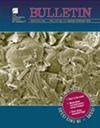西藏南部沃卡断裂下印度岩石圈的始新世撕裂和破碎
IF 3.9
1区 地球科学
Q1 GEOSCIENCES, MULTIDISCIPLINARY
引用次数: 0
摘要
喜马拉雅-西藏高原的同步断裂 N-S 走向裂谷是何时以及如何形成的,这些关键问题尚未解决,但有助于确定地球动力演化与高原隆升之间的相互作用。最近的地球物理观测表明,虽然印度岩石圈撕裂是裂谷形成的最可能触发因素,但这种撕裂的时间仍不确定。为了解决这个问题,我们对代表西藏南部典型 N-S 走向裂谷的沃卡裂谷进行了研究。我们的研究结果表明,在始新世时期,沃卡断裂悬壁和脚壁的花岗岩在岩浆结晶温度(770-860 °C与650-750 °C)和地壳厚度(∼40 km与∼60 km)方面存在显著差异。这些差异很可能与印度岩石圈的撕裂有关。从始新世到渐新世的地壳厚度趋势和基岩隆起深度的整合表明,悬壁的隆起速度快于脚壁。从这些信息来看,沃卡断裂在此期间显然没有经历东西向延伸。综合地球物理学、热时学、地幔衍生、N-S走向的岩钉和阿达克岩的数据,我们提出,始新世期间印度岩石圈的撕裂和破碎导致了西藏中下地壳的减弱,而不是直接引发了沃卡断裂的地表延伸。这项研究对喜马拉雅-西藏高原的深部岩石圈过程和地表反应具有重要意义。本文章由计算机程序翻译,如有差异,请以英文原文为准。
Eocene tearing and fragmentation of Indian lithosphere beneath the Woka rift, southern Tibet
When and how the syncontractional N-S−trending rifts formed in the Himalayan-Tibetan Plateau are crucial, yet unsolved issues that could help establish the interplay between geodynamic evolution and uplift of the plateau. Recent geophysical observations indicate that although Indian lithosphere tearing is the most likely trigger for rift formation, the timing of this tearing remains uncertain. To address this issue, we studied the Woka rift, which represents a typical N-S−trending rift in southern Tibet. Our results show that granitoids from the hanging wall and footwall of the Woka rift have significantly different magma crystallization temperatures (770−860 °C versus 650−750 °C) and crustal thickness (∼40 km versus ∼60 km) during the Eocene. These differences were most likely linked to tearing of the Indian lithosphere. The integration of crustal thickness trends and bedrock emplacement depth from the Eocene to the Oligocene suggest that the hanging wall exhumed at a faster rate than the footwall. From this information, it is clear that the Woka rift did not undergo E-W extension during this period. Integrating data from geophysics, thermochronology, mantle-derived, N-S−trending dikes, and adakitic rocks, we propose that Indian lithospheric tearing and fragmentation during the Eocene caused weakening of the Tibetan middle-lower crust rather than directly triggering surface extension of the Woka rift. This study has significant implications for the deep lithospheric processes and surface responses in the Himalayan-Tibetan Plateau.
求助全文
通过发布文献求助,成功后即可免费获取论文全文。
去求助
来源期刊

Geological Society of America Bulletin
地学-地球科学综合
CiteScore
9.30
自引率
8.20%
发文量
159
审稿时长
4-8 weeks
期刊介绍:
The GSA Bulletin is the Society''s premier scholarly journal, published continuously since 1890. Its first editor was William John (WJ) McGee, who was responsible for establishing much of its original style and format. Fully refereed, each bimonthly issue includes 16-20 papers focusing on the most definitive, timely, and classic-style research in all earth-science disciplines. The Bulletin welcomes most contributions that are data-rich, mature studies of broad interest (i.e., of interest to more than one sub-discipline of earth science) and of lasting, archival quality. These include (but are not limited to) studies related to tectonics, structural geology, geochemistry, geophysics, hydrogeology, marine geology, paleoclimatology, planetary geology, quaternary geology/geomorphology, sedimentary geology, stratigraphy, and volcanology. The journal is committed to further developing both the scope of its content and its international profile so that it publishes the most current earth science research that will be of wide interest to geoscientists.
 求助内容:
求助内容: 应助结果提醒方式:
应助结果提醒方式:


